The Field of “Public Health” as a Component of Sustainable Development—Poland Compared to the European Union
Abstract
1. Introduction
2. Literature Review
- The analysis of operational indicators of sustainable development in the field of public health makes it possible to monitor the commitment of countries to improving health and levelling social inequalities that determine the health condition.
- The results of international comparisons provide information that is a benchmark for the development of the appropriate public health policy in each country.
3. Materials and Methods
- Part I
- Part II
- 1.
- Economic factors
- -
- Expenditure on prevention in health care (in USD per PPP per person)
- -
- Household expenditure in health care (in USD according to PPP per person)
- 2.
- Consumption of medical services
- -
- Number of medical consultations in health care (number of consultations per person)
- 3.
- Environmental factors
- -
- Air pollution with PM10 dust (µg/m3)
- -
- Number of people exposed to noise (percentage of the total number of people)
4. Results
- -
- Four (2017–2018):
- 1.
- Italy, Netherlands, Germany
- 2.
- Sweden, Finland, Ireland, Estonia, Luxembourg, France, Denmark
- 3.
- Slovakia, Hungary, Poland, Slovenia, Czech Republic
- 4.
- Greece, Spain, Latvia, Lithuania, Belgium, Austria
- -
- Five (2019):
- 1.
- Italy, Netherlands, Germany
- 2.
- Slovakia, Poland, Lithuania, Hungary
- 3.
- Sweden, Finland, Ireland, Estonia
- 4.
- Luxembourg, Denmark, Slovenia, France, Czech Republic
- 5.
- Greece, Spain, Latvia, Belgium, Austria
5. Discussion
6. Conclusions
Funding
Data Availability Statement
Conflicts of Interest
References
- The Act of 27 April 2001 Environmental Protection Law. J. Laws 2001, 62, 627.
- Kozaczyński, W. Sustainable development and human safety. Bezpieczeństwo Teor. Prakt. 2012, 4, 75–83. [Google Scholar]
- Misztal, P. Sustainable Development and Quality of Life in Poland Compared to other OECD Member Countries. Eur. Res. Stud. J. 2021, 24, 663–675. [Google Scholar] [CrossRef]
- Sulmicka, M. Public health in the light of sustainable development strategy monitoring indicators. Polityka Społeczna 2010, 11–12, 5–11. [Google Scholar]
- United Nations. The Sustainable Development Agenda—United Nations Sustainable Development. Available online: https://www.un.org/sustainabledevelopment/development-agenda/ (accessed on 10 October 2020).
- Mazur-Wierzbicka, E. Public health as the element of sustainable development–The comparative analysis. Poland against the background of the European Union. Studia Ekon. Zesz. Nauk. 2017, 310, 53–68. [Google Scholar]
- Roorda, N.; Corcoran, P.B.; Weakland, J.P. Fundamentals of Sustainable Development. 2012. Available online: https://sustainabledevelopment.un.org/sdgs (accessed on 20 August 2021).
- Iwuoha, J.C.; Jude-Iwuoha, A.U. Covid-19: Challenge to SDG and Globalization. Electron. Res. J. Soc. Sci. Humanit. 2020, 2, 103–115. [Google Scholar]
- Orłowska, J.; Pawłowska, Z.; Rösler, J. The European Cooperation and Competition within Health Policies during the COVID-19 Pandemic. Available online: https://wnpid.amu.edu.pl/__data/assets/pdf_file/0031/217489/6.-Orlowska,-Pawlowska,-Rosler,-Europejska-wspolpraca-i-rywalizacja-w-zakresie-polityk-zdrowotnych-w-dobie-pandemii-COVID-19.pdf (accessed on 19 August 2021).
- Gabrijelcic, M. COVID-19. Available online: https://eurohealthnet.eu/COVID-19 (accessed on 18 August 2021).
- Stafford, H. Even if You are Virus-Free, COVID-19 is Affecting Your health. Here’s what to Do. Available online: https://scopeblog.stanford.edu/2020/03/13/even-if-you-are-virus-free-covid-19-is-affecting-your-health-heres-what-to-do/ (accessed on 18 August 2021).
- Bergamini, E. How COVID-19 is Laying Bare Inequality. Available online: https://www.bruegel.org/2020/03/how-covid-19-is-laying-bare-inequality/ (accessed on 18 August 2021).
- Blundell, R.; Costa Dias, M.; Joyce, R.; Xu, X. Covid-19 and Inequalities. Available online: https://www.ifs.org.uk/inequality/covid-19-and-Inequalities/ (accessed on 18 August 2021).
- Tsalis, T.A.; Malamateniou, K.E.; Koulouriotis, D.; Nikolaou, I.E. New challenges for corporate sustainability reporting: United Nations’ 2030 Agenda for sustainable development and the sustainable development goals. Corp. Soc. Responsib. Environ. Manag. 2020, 27, 1617–1629. [Google Scholar] [CrossRef]
- Council of the European Union. Renewed EU Sustainable Development Strategy, Bruksela 2006, 26 June 2006, 10917/06. Available online: https://data.consilium.europa.eu/doc/document/ST-10917-2006-INIT/en/pdf (accessed on 6 July 2021).
- The Europa 2020 Strategy Indicators. Available online: https://stat.gov.pl/cps/rde/xbcr/gus/POZ_Wskazniki_Europa2020.pdf (accessed on 1 July 2021).
- European Commission. Taking forward the Strategic Implementation Plan of the European Innovation Partnership on Active and Healthy Ageing, Communication from the Commission to the European Parliament and the Council, Brussels 2012, COM 83 final. Available online: https://eur-lex.europa.eu/LexUriServ/LexUriServ.do?uri=COM:2012:0083:FIN:EN:PDF (accessed on 6 July 2021).
- European Commission. Together for Health: A Strategic Approach for the EU 2008–2013, Commission of the European Communities, Brussels 2007, COM 630 Final. Available online: https://ec.europa.eu/commission/presscorner/detail/en/IP_07_1571 (accessed on 6 July 2021).
- Helbostad, J.L.; Vereijken, B.; Becker, C.; Todd, C.; Taraldsen, K.; Pijnappels, M.; Aminian, K.; Mellone, S. Mobile Health Applications to Promote Active and Healthy Ageing. Sensors 2017, 17, 622. [Google Scholar] [CrossRef] [PubMed]
- European Commission. Investing in Health—Commission Staff Working Document, Commission Staff Working Document Social Investment Package; European Commission: Brussels, Belgium, 2013; Available online: https://ec.europa.eu/health/sites/default/files/policies/docs/swd_investing_in_health.pdf (accessed on 6 July 2021).
- Bornemann, B.; Weiland, S. The UN 2030 Agenda and the Quest for Policy Integration: A Literature Review. Politics Gov. 2021, 9, 96–107. [Google Scholar] [CrossRef]
- Sherman, J.D.; Thiel, C.; MacNeill, A.; Eckelman, M.J.; Dubrow, R.; Hopf, H.; Lagasse, R.; Bialowitz, J.; Costello, A.; Forbes, M.; et al. The Green Print: Advancement of Environmental Sustainability in Healthcare. Resour. Conserv. Recycl. 2020, 161, 104882. [Google Scholar] [CrossRef]
- Wypych-Ślusarska, A.; Głogowska-Ligus, J.; Słowiński, J. Social determinants of health inequalities. Nurs. Public Health 2019, 9, 229–236. [Google Scholar] [CrossRef]
- Mackenbach, J.P.; Valverde, J.R.; Artnik, B.; Bopp, M.; Brønnum-Hansen, H.; Deboosere, P.; Kalediene, R.; Kovács, K.; Leinsalu, M.; Martikainen, P.; et al. Trends in health inequalities in 27 European countries. Proc. Natl. Acad. Sci. USA 2018, 115, 6440–6445. [Google Scholar] [CrossRef] [PubMed]
- Rokicki, T.; Perkowska, A.; Ratajczak, M. Differentiation in Healthcare Financing in EU Countries. Sustainability 2020, 13, 251. [Google Scholar] [CrossRef]
- Singh, S.R. Public Health Spending and Population Health. Am. J. Prev. Med. 2014, 47, 634–640. [Google Scholar] [CrossRef] [PubMed]
- Kiselakova, D.; Stec, M.; Grzebyk, M.; Sofrankova, B. A Multidimensional Evaluation of the Sustainable Development of European Union Countries—An Empirical Study. J. Compet. 2020, 12, 56–73. [Google Scholar] [CrossRef]
- Zakrzewska, B. Sustainable development and quality of life. Autobus Tech. Eksploat. Syst. Transp. 2019, 22, 38–41. [Google Scholar] [CrossRef]
- Bloom, D.E.; Canning, D.; Graham, B.S. Longevity and Life-cycle Savings. Scand. J. Econ. 2003, 105, 319–338. [Google Scholar] [CrossRef]
- Alsan, M.; Bloom, D.E.; Canning, D. The effect of population health on foreign direct investment inflows to low- and middle-income countries. World Dev. 2006, 34, 613–630. [Google Scholar] [CrossRef]
- Sala-i-Martin, X.; Doppelhofer, G.; Miller, R.I. Determinants of long-run growth: A Bayesin averaging of classical estimates (BACE) approach. Am. Econ. Rev. 2004, 94, 813–835. [Google Scholar] [CrossRef]
- Jakubowska, A.; Horváthová, Z. Economic Growth and Health: A Comparative Study of the EU Countries. Econ. Sociol. 2016, 9, 158–168. [Google Scholar] [CrossRef][Green Version]
- Toader, E.; Firtescu, B.-N.; Oprea, F. Determinants of Health Status and Public Policies Implications—Lessons for Romania. Transylv. Rev. Adm. Sci. 2017, 52, 128–147. [Google Scholar] [CrossRef]
- Niciejewska, M.; Kiriliuk, O. Occupational health and safety management in “small size” enterprises, with particular emphasis on hazards identification. Prod. Eng. Arch. 2020, 26, 195–201. [Google Scholar] [CrossRef]
- Machado, C.M.L.; Scavarda, A.; Kipperc, L.M.; Santad, R.; Ferrer, M. Sustainability at the Healthcare Organizations: An Analysis of the Impact on the Environment, Society and Economy. Chem. Eng. Trans. 2015, 45, 727–732. [Google Scholar] [CrossRef]
- Sakharina, I.K.; Kadarudin, K.; Patittingi, F.; Hasrul, M.; Latif, B.; Palutturi, S. The impact of green human resource practices on environmental performance. Pol. J. Manag. Stud. 2020, 22, 470–486. [Google Scholar] [CrossRef]
- Łyszczarz, B.; Nojszewska, E. Determinants of health care expenditure in Europe. Rocz. Kol. Anal. Ekon. Szkoła Główna Handlowa 2015, 39, 183–197. [Google Scholar]
- Piekut, M. Health care expenditure in households—International comparison. Ekon. Zarządzanie 2014, 6, 79–96. [Google Scholar] [CrossRef]
- Nowak, W. Macroeconomic Determinants of Life Length. Available online: http://repozytorium.uni.wroc.pl/Content/118591/PDF/01_03_W_Nowak_Makroekonomiczne_uwarunkowania_dlugosci_zycia.pdf (accessed on 20 August 2021).
- Ryć, K.; Skrzypczak, Z. Epidemic indicators and their economic determinants. In Health Care in the World; Ryć, K., Skrzypczak, Z., Eds.; LEX a Wolters Kluwer Business: Warsaw, Poland, 2011; pp. 19–48. [Google Scholar]
- OECD Home Page. Available online: www.oecd.org (accessed on 15 June 2021).
- Faliński, P. Investment risk management based on quotations of oil companies, oil and dollar. Zesz. Nauk. Uniw. Przyr. Humanist. Siedlcach Ser. Adm. Zarządzanie 2021, 53, 37–45. [Google Scholar] [CrossRef]
- Tambor, M.; Klich, J.; Domagała, A. Financing Healthcare in Central and Eastern European Countries: How Far Are We from Universal Health Coverage? Int. J. Environ. Res. Public Health 2021, 18, 1382. [Google Scholar] [CrossRef] [PubMed]
- Miladinov, G. Socioeconomic development and life expectancy relationship: Evidence from the EU accession candidate countries. Genus 2020, 76, 1–20. [Google Scholar] [CrossRef]
- Aftab, W.; Siddiqui, F.J.; Tasic, H.; Perveen, S.; Siddiqi, S.; Bhutta, Z.A. Implementation of health and health-related sustainable development goals: Progress, challenges and opportunities—A systematic literature review. BMJ Glob. Health 2020, 5, e002273. [Google Scholar] [CrossRef]
- Zalewska, M. Limitations of the set of public health indicators monitored in the context of sustainable development. Probl. Zarz. 2015, 13, 247–260. [Google Scholar] [CrossRef]
- Bluszcz, A. Methods of evaluation of the level of sustainable development—Poland on the background of the European Union. Sci. Pap. Silesian Univ. Technol. Organ. Manag. Ser. 2017, 2017, 35–44. [Google Scholar] [CrossRef]
- Bal-Domańska, B.; Bieńkowska, A. Sustainable development in documents of Eurostat and the Polish Central Statistical Office. Śląski Przegląd Stat. 2014, 12, 225–235. [Google Scholar] [CrossRef]
- Teneta-Skwiercz, D. The sustainable development measurement indicators—Poland against the background of the European Union countries. Pr. Nauk. Uniw. Ekon. Wrocławiu 2018, 516, 121–132. [Google Scholar] [CrossRef]
- Urbaniec, M. The sustainable development measurement system in the European Union. Acta Univ. Lodz. Folia Oeconomica 2015, 2, 147–163. [Google Scholar] [CrossRef]
- Seke, K.; Petrovic, N.; Jeremic, V.; Vukmirović, J.; Kilibarda, B.; Martic, M. Sustainable development and public health: Rating European countries. BMC Public Health 2013, 13, 77. [Google Scholar] [CrossRef] [PubMed]
- Hosseinpoor, A.R.; Bergen, N.; Schlotheuber, A.; Grove, J. Measuring health inequalities in the context of sustainable development goals. Bull. World Health Organ. 2018, 96, 654–659. [Google Scholar] [CrossRef]
- Asma, S.; Lozano, R.; Chatterji, S.; Swaminathan, S.; Marinho, M.D.F.; Yamamoto, N.; Varavikova, E.; Misganaw, A.; Ryan, M.; Dandona, L.; et al. Monitoring the health-related Sustainable Development Goals: Lessons learned and recommendations for improved measurement. Lancet 2020, 395, 240–246. [Google Scholar] [CrossRef]
- European Commission. Reducing Health Inequalities in the European Union. 2011. Available online: https://akademia.nfz.gov.pl/wp-content/uploads/2016/05/KE3010290PLC.pdf (accessed on 22 August 2021).
- Kauf, S. Higher education—A factor in sustainable regional development. Sci. Pap. Silesian Univ. Technol. Organ. Manag. Ser. 2017, 2017, 93–102. [Google Scholar] [CrossRef]
- Girum, T.; Muktar, E.; Shegaze, M. Determinants of life expectancy in low and medium human development index countries. Med. Stud. 2018, 34, 218–225. [Google Scholar] [CrossRef]
- Kuszewski, K. “The national health programme” as a tool of the state health policy. In Health of Polish People; Ciura, G., Ed.; Studia BAS: Warsaw, Poland, 2009; Volume 4, pp. 51–77. [Google Scholar]
- Rój, J. Inequality in the Distribution of Healthcare Human Resources in Poland. Sustainability 2020, 12, 2043. [Google Scholar] [CrossRef]
- Rabiej, E. Transformation of the health care system in Poland—On the way to sustainable development. In Finansowanie Zadań Publicznych w Polsce; Russel, P., Ed.; Studia BAS: Warsaw, Poland, 2017; Volume 4, pp. 121–142. [Google Scholar]
- Gostin, L.O.; Friedman, E.A. Health Inequalities. Häst. Cent. Rep. 2020, 50, 6–8. [Google Scholar] [CrossRef]
- Bambra, C.; Riordan, R.; Ford, J.; Matthews, F. The COVID-19 pandemic and health inequalities. J. Epidemiol. Community Health 2020, 74, 964–968. [Google Scholar] [CrossRef] [PubMed]
- Mishra, V.; Seyedzenouzi, G.; Almohtadi, A.; Chowdhury, T.; Khashkhusha, A.; Axiaq, A.; Wong, W.Y.E.; Harky, A. Health Inequalities During COVID-19 and Their Effects on Morbidity and Mortality. J. Health Leadersh. 2021, 13, 19–26. [Google Scholar] [CrossRef]
- Nerini, F.F.; Henrysson, M.; Swain, A.; Swain, R.B. Sustainable Development in the Wake of Covid-19. Available online: https://assets.researchsquare.com/files/rs-63414/v1/9a1b26f1-34c2-40ee-8e3c-179898e11d34.pdf?c=1614773047 (accessed on 22 August 2021).
- Kaczmarek, F. The COVID-19 Pandemic and the Sustainable Development Goals. In The COVID-19 Pandemic Consequences: The World and Economy; Hajder, K., Kacperska, M., Donaj, Ł., Eds.; Wydawnictwo Naukowe Uniwersytetu im. Adama Mickiewicza: Poznan, Poland, 2020; pp. 159–172. [Google Scholar]
- Panek, T. Statistical Methods of Multidimensional Comparative Analysis; Oficyna Wydawnicza Szkoły Głównej Handlowej: Warsaw, Poland, 2009; 343p. [Google Scholar]
- Malina, A. The Multidimensional Analysis of the Spatial Diversification of the Poland’s Economic Structure According to Voivodeships; Wydawnictwo Akademii Ekonomicznej w Krakowie: Krakow, Poland, 2004; 232p. [Google Scholar]
- Eszergár-Kiss, D.; Caesar, B. Definition of user groups applying Ward’s method. Transp. Res. Procedia 2017, 22, 25–34. [Google Scholar] [CrossRef]
- Wang, F. The roles of preventive and curative health care in economic development. PLoS ONE 2018, 13, e0206808. [Google Scholar] [CrossRef] [PubMed]
- Björnberg, A. Euro Health Consumer Index 2017 Raport Health Consumer Powerhouse. 2018. Available online: https://healthpowerhouse.com/ehci-2017/ (accessed on 1 July 2021).
- OECD. Agenda for Sustainable Development 2030: In the Direction of Successful Implementation in Poland. 2017. Available online: https://www.oecd.org/poland/Better-Policy-Series-Poland-Nov-2017-PL.pdf (accessed on 21 June 2021).
- Ulewicz, R.; Blašková, M. Sustainable development and knowledge management from the stakeholders’ point of view. Pol. J. Manag. Stud. 2018, 18, 363–374. [Google Scholar] [CrossRef]
- Bambra, C.; Gibson, M.; Sowden, A.; Wright, K.; Whitehead, M.; Petticrew, M. Working for health? Evidence from systematic reviews on the effects on health and health inequalities of organisational changes to the psychosocial work environment. Prev. Med. 2009, 48, 454–461. [Google Scholar] [CrossRef] [PubMed]
- Jakovljevic, M. Population ageing alongside health care spending growth. Srp. Arh. Celok. Lek. 2017, 145, 534–539. [Google Scholar] [CrossRef]
- Burzyńska, M.; Marcinkowski, J.T.; Bryła, M.; Maniecka-Bryła, I. Life Expectancy and Healthy Life Years as the basic evaluation measures of the population health situation. Probl. Hig. Epidemiol. 2010, 91, 530–536. [Google Scholar]
- Łobodzińska, A. Aging society as a challenge to sustainable development. Geogr. Studies. 2016, 144, 127–142. [Google Scholar] [CrossRef]
- Marszowski, R.; Drobek, L. Selected aspects of demographic changes and its impact on the labor market and education. Sci. Pap. Sil. Univ. Technol. Organ. Manag. Ser. 2020, 2020, 193–206. [Google Scholar] [CrossRef]
- Hady, J.; Leśniowska, M. Analysis of Polish healthcare system financing in 2000–2009. Financ. Internet Quart. 2013, 9, 1–11. [Google Scholar]
- De Meijer, C.; Wouterse, B.; Polder, J.; Koopmanschap, M. The effect of population aging on health expenditure growth: A critical review. Eur. J. Ageing 2013, 10, 353–361. [Google Scholar] [CrossRef] [PubMed]
- Van Eenoo, L.; Declercq, A.; Onder, G.; Finne-Soveri, H.; Garms-Homolová, V.; Jónsson, P.V.; Dix, O.H.; Smit, J.H.; van Hout, H.P.; van der Roest, H.G. Substantial between-country differences in organising community care for older people in Europe—A review. Eur. J. Public Health 2016, 26, 213–219. [Google Scholar] [CrossRef]
- Cristea, M.; Noja, G.G.; Stefea, P.; Sala, A.L. The Impact of Population Aging and Public Health Support on EU Labor Markets. Int. J. Environ. Res. Public Health 2020, 17, 1439. [Google Scholar] [CrossRef] [PubMed]
- Nieszporska, S. Priorities in the Polish health care system. Eur. J. Health Econ. 2016, 18, 1–5. [Google Scholar] [CrossRef]
- Eurostat Home Page. Available online: www.ec.europa.eu/eurostat (accessed on 17 June 2021).
- Djellal, F.; Gallouj, F. Innovation in hospitals: A survey of the literature. Eur. J. Health Econ. 2006, 8, 181–193. [Google Scholar] [CrossRef]
- Jacobs, R.J.; Lou, J.Q.; Ownby, R.; Caballero, J. A systematic review of eHealth interventions to improve health literacy. Health Inform. J. 2014, 22, 81–98. [Google Scholar] [CrossRef] [PubMed]
- Silva, B.M.; Rodrigues, J.J.; Díez, I.D.L.T.; López-Coronado, M.; Saleem, K. Mobile-health: A review of current state in 2015. J. Biomed. Inform. 2015, 56, 265–272. [Google Scholar] [CrossRef]
- Strzelecka, A. The analysis of public health care expenditure in the selected EU countries as the basis of the decision making process in the common health policy. In Proceedings of the 3rd International Conference on European Integration 2016, Ostrava, Czech Republic, 19–20 May 2016. [Google Scholar]
- Ivanková, V.; Rigelský, M.; Kotulič, R.; Gonos, J. The governance of efficient healthcare financing system in OECD countries. Pol. J. Manag. Stud. 2020, 21, 179–194. [Google Scholar] [CrossRef]
- Golinowska, S.; Tabor, M. Sources of health care funding. Zdr. Publiczne Zarządzanie 2014, 12, 205–217. [Google Scholar]
- Jarzebski, M.P.; Elmqvist, T.; Gasparatos, A.; Fukushi, K.; Eckersten, S.; Haase, D.; Goodness, J.; Khoshkar, S.; Saito, O.; Takeuchi, K.; et al. Ageing and population shrinking: Implications for sustainability in the urban century. npj Urban Sustain. 2021, 1, 1–11. [Google Scholar] [CrossRef]
- Carrilero, N.; García-Altés, A.; Mendicuti, V.M.; García, B.R. Do governments care about socioeconomic inequalities in health? Narrative review of reports of EU-15 countries. Eur. Policy Anal. 2021, 1–16. [Google Scholar] [CrossRef]
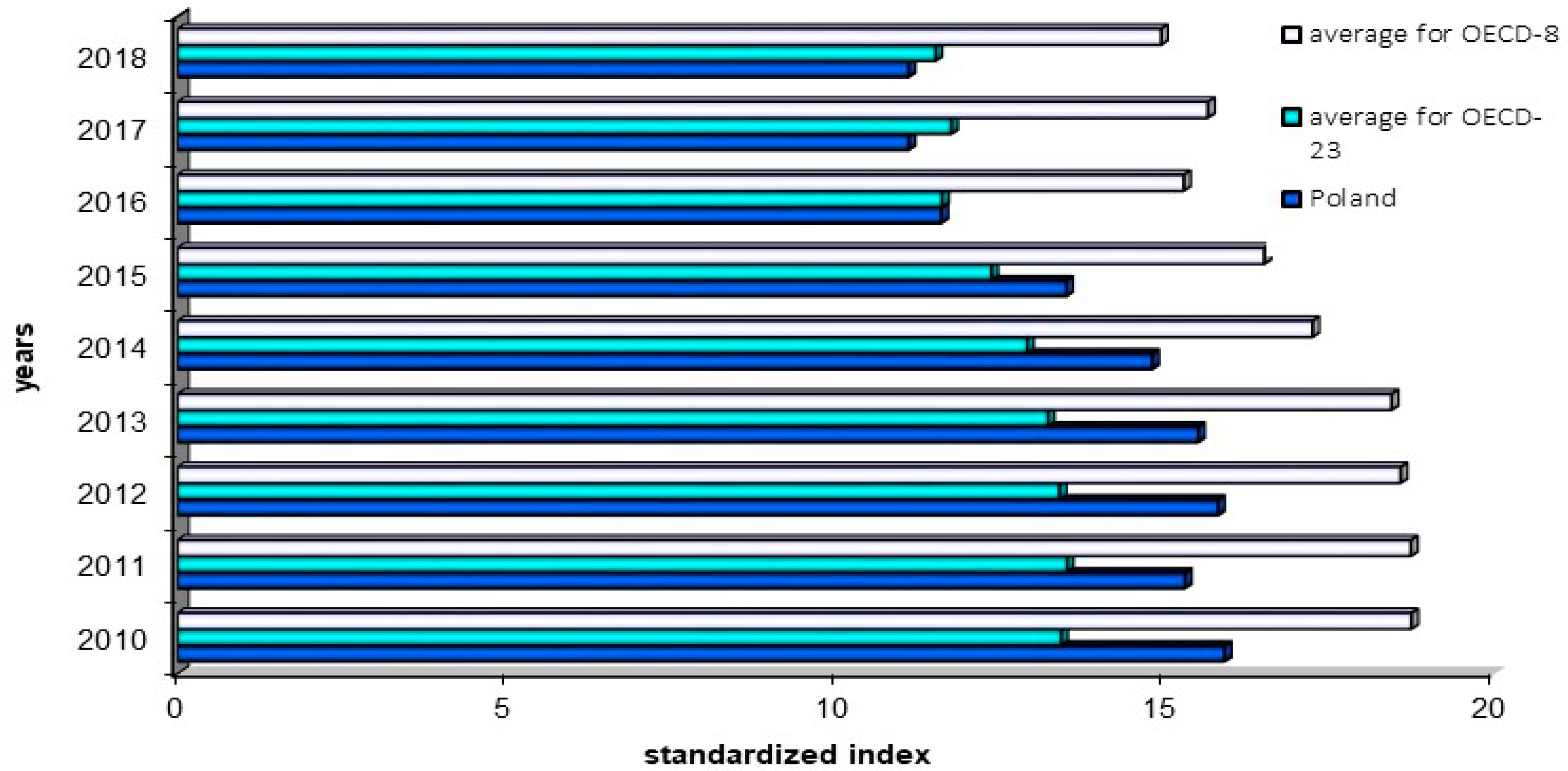
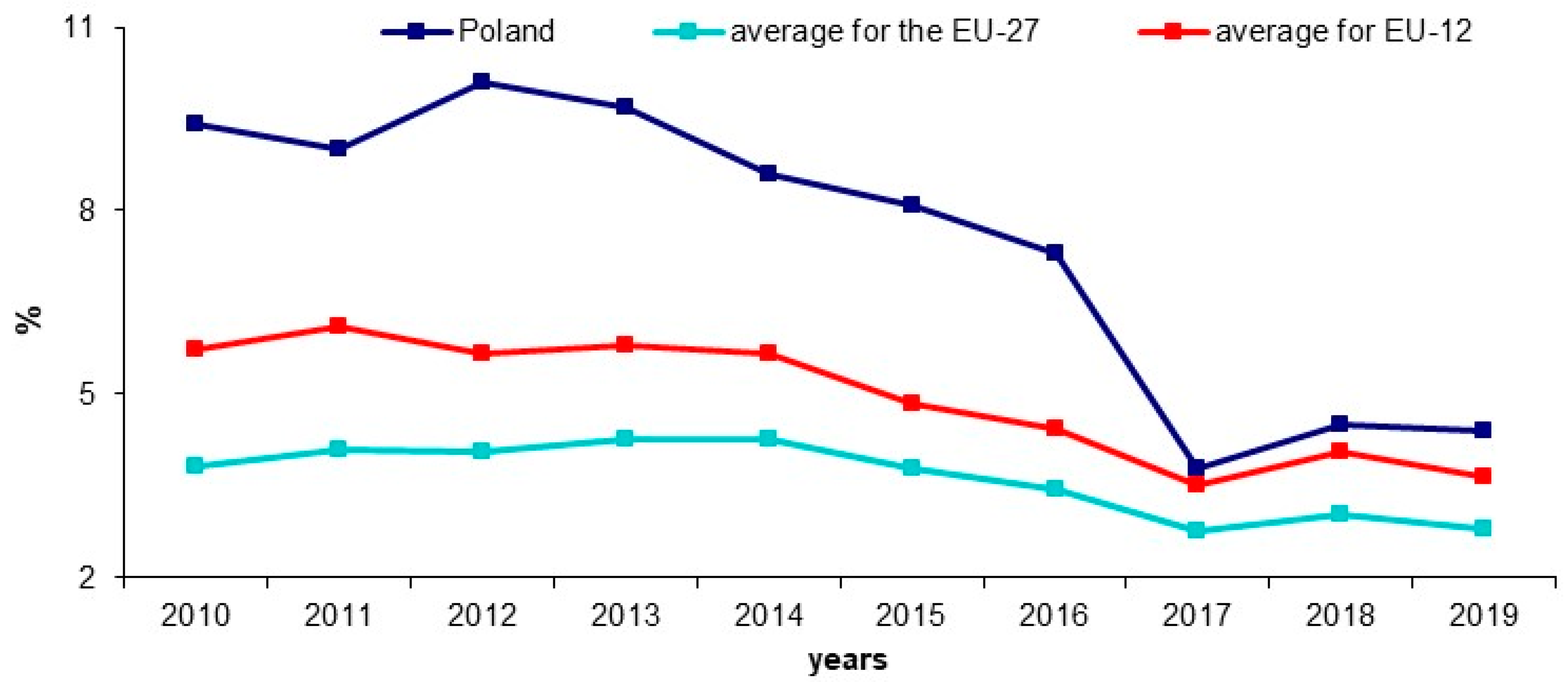
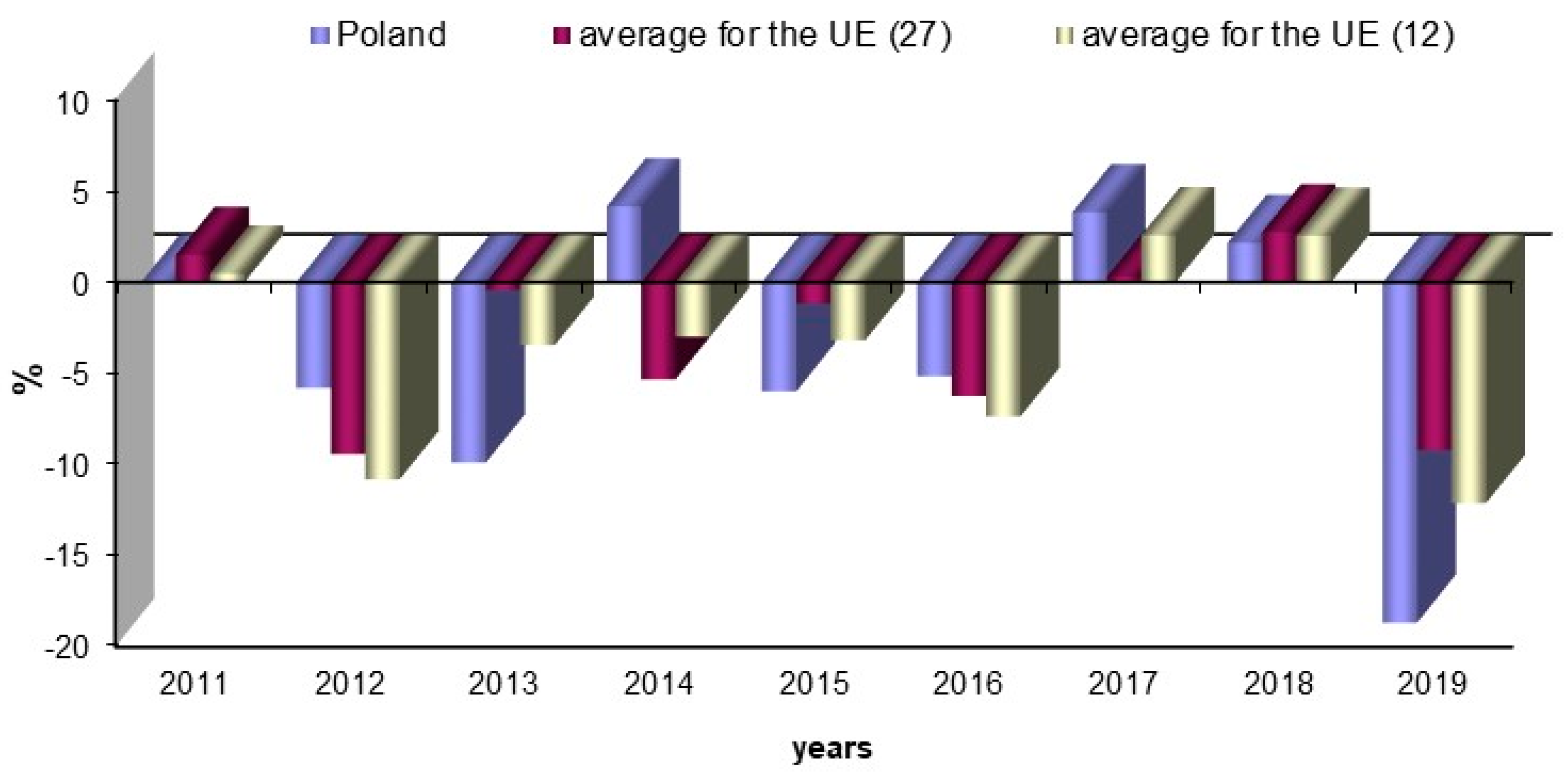


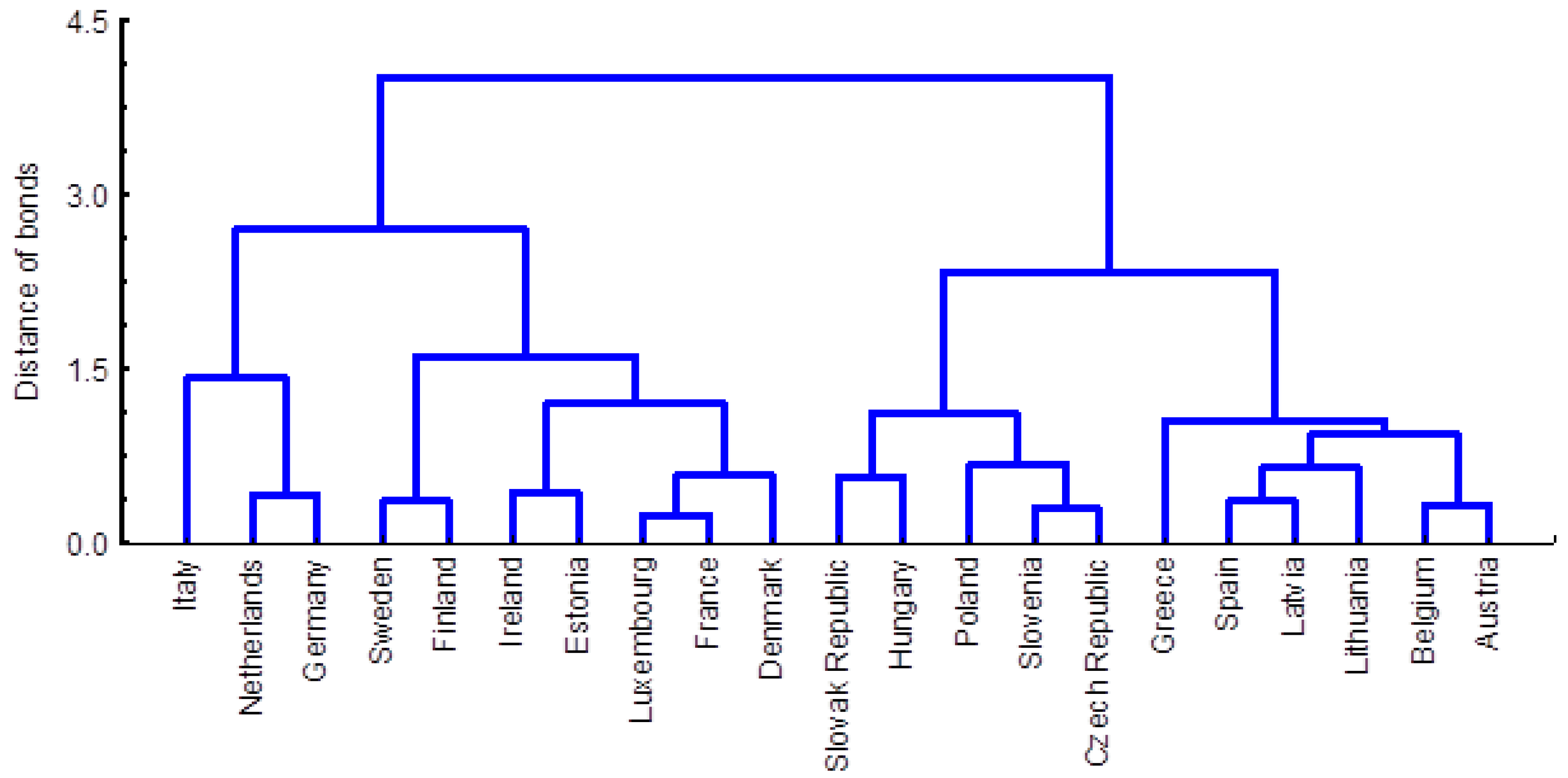
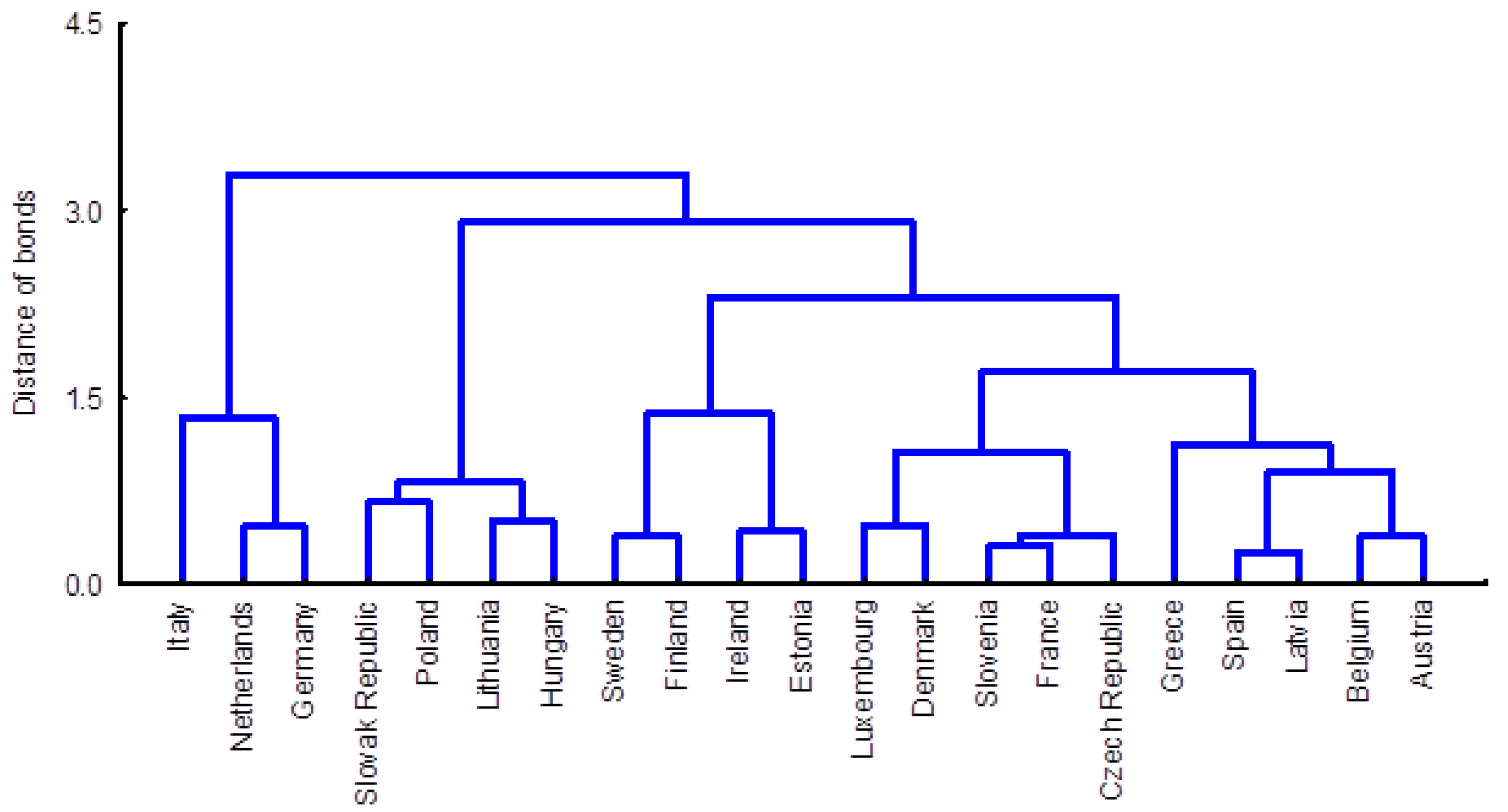
| Groups | The Statistical Measure | 2010 | 2011 | 2012 | 2013 | 2014 | 2015 | 2016 | 2017 | 2018 | 2019 |
|---|---|---|---|---|---|---|---|---|---|---|---|
| Women | |||||||||||
| Poland | 80.7 | 81.1 | 81.1 | 81.2 | 81.7 | 81.6 | 82.0 | 81.8 | 81.7 | 81.9 | |
| 27 EU countries | average | 82.0 | 82.3 | 82.3 | 82.6 | 82.9 | 82.7 | 83.0 | 83.0 | 83.1 | 83.4 |
| median | 83.0 | 83.1 | 83.1 | 83.2 | 83.6 | 83.4 | 83.6 | 83.9 | 83.9 | 84.2 | |
| Countries belonging to the EU since 2004 | average | 80.2 | 80.5 | 80.6 | 81.0 | 81.2 | 81.0 | 81.5 | 81.4 | 81.6 | 81.8 |
| median | 80.0 | 80.5 | 80.5 | 80.7 | 81.1 | 80.9 | 81.4 | 81.3 | 81.3 | 81.6 | |
| Men | |||||||||||
| Poland | 72.2 | 72.5 | 72.6 | 73.0 | 73.7 | 73.5 | 73.9 | 73.9 | 73.7 | 74.1 | |
| 27 EU countries | average | 75.7 | 76.0 | 76.2 | 76.6 | 76.9 | 76.9 | 77.2 | 77.3 | 77.4 | 77.7 |
| median | 77.5 | 77.9 | 78.0 | 78.1 | 78.7 | 78.7 | 78.9 | 78.9 | 79.1 | 79.3 | |
| Countries belonging to the EU since 2004 | average | 72.6 | 72.9 | 73.1 | 73.6 | 73.9 | 73.9 | 74.3 | 74.4 | 74.5 | 74.9 |
| median | 71.4 | 71.9 | 72.1 | 72.9 | 72.9 | 73.2 | 73.6 | 73.8 | 73.8 | 74.2 | |
| Groups | The Statistical Measure | 2010 | 2011 | 2012 | 2013 | 2014 | 2015 | 2016 | 2017 | 2018 | 2019 |
|---|---|---|---|---|---|---|---|---|---|---|---|
| Women | |||||||||||
| Poland | 62.3 | 63.2 | 62.8 | 62.7 | 62.7 | 63.2 | 64.6 | 63.5 | 64.3 | 64.1 | |
| 27 EU countries | average | 61.7 | 61.7 | 62.1 | 61.8 | 62.2 | 61.7 | 62.7 | 62.1 | 62.1 | 62.9 |
| median | 62.3 | 62.0 | 62.6 | 62.2 | 62.3 | 62.7 | 63.1 | 62.0 | 61.8 | 62.6 | |
| Countries belonging to the EU since 2004 | average | 60.8 | 60.3 | 61.1 | 61.3 | 61.9 | 60.9 | 62.1 | 60.8 | 61.0 | 62.0 |
| median | 60.5 | 60.1 | 61.0 | 60.9 | 61.2 | 59.7 | 59.8 | 60.3 | 60.7 | 61.9 | |
| Men | |||||||||||
| Poland | 58.5 | 59.1 | 59.1 | 59.2 | 59.8 | 60.1 | 61.3 | 60.6 | 60.5 | 60.9 | |
| 27 EU countries | average | 60.8 | 61.1 | 61.3 | 61.2 | 61.4 | 61.4 | 62.1 | 61.7 | 61.8 | 62.2 |
| median | 61.3 | 62.1 | 62.1 | 62.0 | 62.0 | 61.5 | 62.6 | 60.6 | 61.5 | 61.8 | |
| Countries belonging to the EU since 2004 | average | 58.6 | 58.4 | 59.1 | 59.4 | 59.7 | 59.2 | 60.3 | 59.3 | 59.3 | 60.1 |
| median | 57.3 | 57.6 | 58.4 | 58.9 | 59.0 | 58.8 | 59.7 | 59.4 | 59.8 | 60.8 | |
| Groups | 2010 | 2011 | 2012 | 2013 | 2014 | 2015 | 2016 | 2017 | 2018 | 2019 |
|---|---|---|---|---|---|---|---|---|---|---|
| Neoplasms | ||||||||||
| Poland | 25.4 | 25.5 | 25.6 | 25.5 | 26.6 | 26.7 | 27.3 | 26.5 | 26.3 | 26.5 |
| Average for the 27 EU countries | 25.6 | 26.0 | 25.8 | 26.0 | 26.6 | 25.7 | 26.2 | 25.8 | 25.9 | 26.1 |
| Average for EU countries since 2004 | 23.3 | 23.6 | 23.6 | 24.0 | 24.5 | 24.0 | 24.4 | 24.0 | 24.4 | 24.7 |
| Diabetes mellitus | ||||||||||
| Poland | 1.7 | 1.8 | 1.9 | 1.9 | 1.8 | 2.1 | 2.1 | 2.2 | 2.2 | 2.3 |
| Average for the 27 EU countries | 2.1 | 2.1 | 2.1 | 2.2 | 2.3 | 2.3 | 2.3 | 2.3 | 2.3 | 2.4 |
| Average for EU countries since 2004 | 2.0 | 2.0 | 1.9 | 2.2 | 2.3 | 2.3 | 2.3 | 2.3 | 2.5 | 2.6 |
| Diseases of the circulatory system | ||||||||||
| Poland | 50.5 | 49.9 | 49.6 | 49.7 | 49.7 | 49.7 | 49.5 | 49.8 | 49.4 | 49.4 |
| Average for the 27 EU countries | 42.3 | 42.0 | 41.8 | 41.0 | 40.5 | 40.3 | 39.5 | 39.1 | 38.2 | 38.0 |
| Average for EU countries since 2004 | 51.1 | 51.0 | 50.9 | 50.1 | 49.8 | 49.8 | 49.0 | 48.8 | 47.8 | 47.7 |
| Cerebrovascular diseases | ||||||||||
| Poland | 9.4 | 9.5 | 9.0 | 8.5 | 8.2 | 7.7 | 7.5 | 7.6 | 7.2 | 7.1 |
| Average for the 27 EU countries | 10.1 | 9.9 | 9.6 | 9.5 | 9.3 | 9.1 | 8.9 | 8.6 | 8.5 | 8.3 |
| Average for EU countries since 2004 | 12.1 | 12.0 | 11.7 | 11.7 | 11.6 | 11.2 | 11.1 | 10.8 | 10.7 | 10.5 |
| Chronic lower respiratory diseases | ||||||||||
| Poland | 1.9 | 2.0 | 1.9 | 2.0 | 1.7 | 1.8 | 1.7 | 1.8 | 1.7 | 1.6 |
| Average for the 27 EU countries | 3.1 | 3.0 | 3.1 | 3.1 | 3.1 | 3.2 | 3.1 | 3.2 | 3.2 | 3.2 |
| Average for EU countries since 2004 | 2.0 | 2.0 | 2.0 | 2.2 | 2.2 | 2.3 | 2.2 | 2.2 | 2.2 | 2.2 |
| Groups | 2010 | 2011 | 2012 | 2013 | 2014 | 2015 | 2016 | 2017 | 2018 | 2019 |
|---|---|---|---|---|---|---|---|---|---|---|
| First quintile | ||||||||||
| Poland | 36.1 | 35.5 | 35.4 | 34.3 | 35.3 | 36.4 | 38.6 | 43.0 | 45.2 | 46.6 |
| Average for the 27 EU countries | 36.2 | 35.8 | 36.2 | 36.7 | 37.2 | 38.7 | 38.8 | 40.9 | 42.2 | 42.5 |
| Average for EU countries since 2004 | 36.2 | 35.8 | 37.3 | 37.2 | 38.1 | 39.9 | 40.7 | 44.2 | 46.1 | 46.3 |
| Second quintile | ||||||||||
| Poland | 37.3 | 38.2 | 38.7 | 37.9 | 37.0 | 39.6 | 40.6 | 43.0 | 41.9 | 42.5 |
| Average for the 27 EU countries | 37.1 | 37.6 | 37.7 | 38.8 | 38.6 | 39.7 | 39.0 | 40.0 | 39.6 | 40.1 |
| Average for EU countries since 2004 | 37.8 | 39.0 | 39.1 | 40.0 | 39.4 | 41.2 | 41.0 | 42.9 | 41.7 | 42.4 |
| Third quintile | ||||||||||
| Poland | 36.0 | 34.6 | 36.4 | 35.4 | 36.2 | 38.5 | 38.9 | 39.7 | 38.8 | 40.7 |
| Average for the 27 EU countries | 31.5 | 32.6 | 31.9 | 32.8 | 33.0 | 33.8 | 33.5 | 34.0 | 33.1 | 33.0 |
| Average for EU countries since 2004 | 32.3 | 33.1 | 32.4 | 32.7 | 33.4 | 33.7 | 33.3 | 34.2 | 33.4 | 32.9 |
| Fourth quintile | ||||||||||
| Poland | 31.3 | 34.0 | 33.0 | 33.7 | 33.5 | 34.9 | 34.3 | 37.3 | 34.1 | 34.2 |
| Average for the 27 EU countries | 27.0 | 27.2 | 27.3 | 28.4 | 28.1 | 28.9 | 28.5 | 29.7 | 28.8 | 28.6 |
| Average for EU countries since 2004 | 27.4 | 27.8 | 27.1 | 27.6 | 27.5 | 27.9 | 27.8 | 29.4 | 28.1 | 27.7 |
| Groups | 2011 | 2012 | 2013 | 2014 | 2015 | 2016 | 2017 | 2018 | 2019 |
|---|---|---|---|---|---|---|---|---|---|
| 2010 = 100% | |||||||||
| Poland | 86.4 | 89.4 | 90.0 | 86.8 | 79.6 | 84.9 | 81.5 | 87.0 | 80.4 |
| Average for the 27 EU countries | 105.1 | 105.2 | 104.1 | 101.1 | 96.6 | 96.1 | 95.3 | 96.3 | 92.5 |
| Average for EU countries since 2004 | 102.4 | 99.0 | 98.8 | 94.2 | 85.1 | 83.5 | 81.5 | 82.3 | 77.2 |
| Previous year = 100% | |||||||||
| Poland | 86.4 | 103.5 | 100.7 | 96.4 | 91.8 | 106.6 | 95.9 | 106.8 | 92.5 |
| Average for the 27 EU countries | 96.7 | 100.1 | 99.0 | 97.1 | 95.5 | 99.5 | 99.2 | 101.1 | 96.0 |
| Average for EU countries since 2004 | 95.1 | 96.7 | 99.8 | 95.3 | 90.4 | 98.0 | 97.7 | 101.0 | 93.8 |
Publisher’s Note: MDPI stays neutral with regard to jurisdictional claims in published maps and institutional affiliations. |
© 2021 by the author. Licensee MDPI, Basel, Switzerland. This article is an open access article distributed under the terms and conditions of the Creative Commons Attribution (CC BY) license (https://creativecommons.org/licenses/by/4.0/).
Share and Cite
Strzelecka, A. The Field of “Public Health” as a Component of Sustainable Development—Poland Compared to the European Union. Sustainability 2021, 13, 10351. https://doi.org/10.3390/su131810351
Strzelecka A. The Field of “Public Health” as a Component of Sustainable Development—Poland Compared to the European Union. Sustainability. 2021; 13(18):10351. https://doi.org/10.3390/su131810351
Chicago/Turabian StyleStrzelecka, Agnieszka. 2021. "The Field of “Public Health” as a Component of Sustainable Development—Poland Compared to the European Union" Sustainability 13, no. 18: 10351. https://doi.org/10.3390/su131810351
APA StyleStrzelecka, A. (2021). The Field of “Public Health” as a Component of Sustainable Development—Poland Compared to the European Union. Sustainability, 13(18), 10351. https://doi.org/10.3390/su131810351






